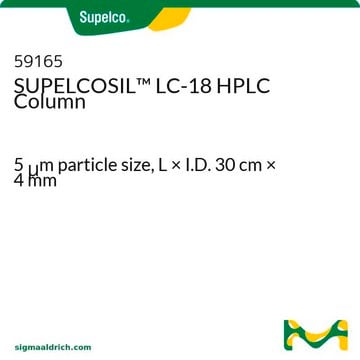The guard column kit for Product No. 565325-U is 565371-U. This kit includes one cartridge, stand-alone holder, a piece of tubing, 2 nuts and 2 ferrules. A set of two replacement cartridges is Product No. 565370-U.
565325-U
Ascentis® RP-Amide (5 µm) HPLC Columns
L × I.D. 25 cm × 4.6 mm, HPLC Column
Sinônimo(s):
RP-Amide Reversed-Phase Chromatography Column
About This Item
Produtos recomendados
Nome do produto
Ascentis® RP-Amide HPLC Column, 5 μm particle size, L × I.D. 25 cm × 4.6 mm
Materiais
stainless steel column
Nível de qualidade
Agency
suitable for USP L60
linha de produto
Ascentis®
Características
endcapped
fabricante/nome comercial
Ascentis®
embalagem
1 ea of
Extensão da rotulagem
19.5% Carbon loading
Parâmetros
≤70 °C temp. range
400 bar pressure (5801 psi)
técnica(s)
HPLC: suitable
LC/MS: suitable
C × D.I.
25 cm × 4.6 mm
área da superfície
450 m2/g
cobertura de superfície
2.7 μmol/m2
Impurezas
<5 ppm metals
Matriz
fully porous particle
silica gel high purity, spherical
Grupo ativo da matriz
amide, alkyl phase
tamanho de partícula
5 μm
tamanho de poro
100 Å
Faixa de pH operacional
2-8
aplicação(ões)
environmental
food and beverages
técnica de separação
reversed phase
Procurando produtos similares? Visita Guia de comparação de produtos
Categorias relacionadas
Descrição geral
Ascentis RP-Amide is a new generation ultra low bleed, embedded polar group (EPG) phase that provides orthogonal selectivity and increased resolution for HPLC and LC-MS analysis of polar compounds. The Ascentis RP-Amide is the first choice in embedded polar group HPLC phases.
Aplicação
- A validated UHPLC method for the determination of caffeoylquinic and di-caffeoylquinic acids in green coffee extracts using an RP-Amide fused-core column.: This study presents a validated Ultra-High-Performance Liquid Chromatography (UHPLC) method employing an RP-Amide fused-core column for the quantitative determination of caffeoylquinic and di-caffeoylquinic acids in green coffee extracts. The method demonstrated excellent precision, accuracy, and sensitivity, making it a valuable tool for the analysis of these bioactive compounds in complex matrices. The research highlights the utility of the Ascentis® RP-Amide HPLC Column in enhancing the resolution and efficiency of chromatographic separations in analytical chemistry applications (Fibigr et al., 2018).
Características e benefícios
- Excellent retention and peak shape for polar compounds
- 100% aqueous compatibility
- Ultra low bleed, LC-MS compatible
- Unique selectivity
Informações legais
produto relacionado
Código de classe de armazenamento
11 - Combustible Solids
Classe de risco de água (WGK)
WGK 3
Ponto de fulgor (°F)
Not applicable
Ponto de fulgor (°C)
Not applicable
Escolha uma das versões mais recentes:
Já possui este produto?
Encontre a documentação dos produtos que você adquiriu recentemente na biblioteca de documentos.
Os clientes também visualizaram
-
What is the Product No of the guard column for Product No. 565325-U Ascentis RP-Amide HPLC column?
1 answer-
Helpful?
-
-
What solvent should Product No. 565325-U Ascentis RP-Amide HPLC Column be stored in?
1 answer-
Product No. 565325-U should be stored in 100% acetonitrile after any buffers have been flushed out.
Helpful?
-
-
What is the Department of Transportation shipping information for this product?
1 answer-
Transportation information can be found in Section 14 of the product's (M)SDS.To access the shipping information for this material, use the link on the product detail page for the product.
Helpful?
-
-
Can I use Ascentis Express on a UHPLC system?
1 answer-
Yes. Ascentis Express columns are packed in a way making them suitable for these ultra high pressure instruments. In fact, Ascentis Express outperforms sub-2 μm micron columns on many applications since Ascentis Express provides the benefits of sub-2 μm particles but at much lower back pressure. These benefits include the capability of providing fast HPLC and higher resolution chromatography. The Fused-Core particle consists of a 1.7 μm solid core and a 0.5 μm porous shell. A major benefit of the Fused-Core particle is the small diffusion path (0.5 μm) compared to conventional fully porous particles. The shorter diffusion path reduces axial dispersion of solutes and minimizes peak broadening.
Helpful?
-
Active Filters
Nossa equipe de cientistas tem experiência em todas as áreas de pesquisa, incluindo Life Sciences, ciência de materiais, síntese química, cromatografia, química analítica e muitas outras.
Entre em contato com a assistência técnica









